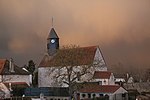Évry Cathedral
1995 establishments in France20th-century Roman Catholic church buildings in FranceBrick buildings and structuresBuildings and structures in Évry, EssonneChurches in Essonne ... and 4 more
Mario Botta buildingsModernist architecture in FranceRoman Catholic cathedrals in FranceRoman Catholic churches completed in 1995

Évry Cathedral (French: Cathédrale de la Résurrection d'Évry; "Évry Cathedral of the Resurrection") is a Roman Catholic church located in the new town of Évry (Essonne), France. The cathedral was designed by Swiss architect Mario Botta. It opened in 1995 and was consecrated and dedicated to Saint Corbinian in 1996. It is the only cathedral begun and completed in France in the 20th century.
Excerpt from the Wikipedia article Évry Cathedral (License: CC BY-SA 3.0, Authors, Images).Évry Cathedral
Clos de la Cathédrale, Évry
Geographical coordinates (GPS) Address Website External links Nearby Places Show on map
Geographical coordinates (GPS)
| Latitude | Longitude |
|---|---|
| N 48.623611111111 ° | E 2.4286111111111 ° |
Address
Cathédrale de la Résurrection Saint-Corbinien
Clos de la Cathédrale
91000 Évry
Ile-de-France, France
Open on Google Maps






